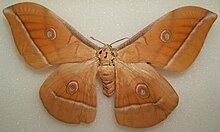Antheraea pernyi
| Antheraea pernyi | |
|---|---|

| |
| Mounted female | |

| |
| Living specimen | |
| Scientific classification | |
| Domain: | Eukaryota |
| Kingdom: | Animalia |
| Phylum: | Arthropoda |
| Class: | Insecta |
| Order: | Lepidoptera |
| Family: | Saturniidae |
| Genus: | Antheraea |
| Species: | A. pernyi
|
| Binomial name | |
| Antheraea pernyi (Guérin-Méneville, 1855)
| |
| Synonyms | |
| |
Antheraea pernyi, the Chinese
They are originally from southern China. Used for tussar silk production, they have been distributed more widely across subtropical and tropical Asia. Unlike the domestic silk moth which is entirely dependent on human care, tussah silk moths can survive in the wild if they escape from captivity; small local populations of such feral stock may thus occasionally occur. The colour and quality of the silk depends on the climate and soil.[3]
This is one of the major producers of tussar silk.
This silkworm is raised in China for its silk. It is referred to as tussah, Chinese tussah, oak tussah, or temperate tussah. It is the source of tussah spinning fiber that is used in the West. It is a relative of the tropical tussah silk moth, Antheraea paphia of India, and also related to Antheraea polyphemus, the American polyphemus silk moth. In China, they are fed on plantations of specially trimmed oak trees on the hillsides.[5]
Immune system
The immune responses of A. pernyi to bacterial infection have been analysed based on injection by
Aging
Changes occurring with aging at the dendrite level of olfactory receptor neurons were studied in male A peryni[9]. These aging related changes included DNA fragmentation[9].
Gallery
-
Eggs one day before hatching
-
First-instar caterpillars
-
Second-instar caterpillar
-
Third-instar caterpillar
-
Fourth-instar caterpillar
-
Fifth-instar caterpillars
-
Sixth-instar caterpillar
-
Sixth-instar caterpillar
References
- ^ PMID 16644243.
- ^ Peigler, Richard S. "Diverse evidence that Antheraea pernyi (Lepidoptera: Saturniidae) is entirely of sericultural origin". Tropical Lepidoptera Research. 22 (2): 93–99.
- ^ "Chapter 9". Fao.org. Archived from the original on 2012-10-21. Retrieved 2011-10-18.
- PMID 28535207.
- ^ "Antheraea pernyi, Chinese Oak Tasar Silkworm". www.wormspit.com. Retrieved 11 July 2019.
- PMID 6754375.
- PMID 3298221.
- S2CID 46056395.
- ^ a b Kumar GL, Pophof B, Kumar S, Keil TA. Age-related changes in the dendrites of olfactory receptor neurons in the male silkmoth Antheraea peryni (Insecta, Lepidoptera: Saturniidae). Cell Biol Int. 1998;22(6):445-55. doi: 10.1006/cbir.1998.0278. PMID: 10328853
- North-Szigetváry, L. (1894): "The Japanese and Chinese Oak-Silk Spinner: Their Life and Cultivation (Attacus Jama-mâi and Bombyx Pernyi)." L. North-Szigetváry, of Newchwang. The Journal of the Manchester Geographical Society. 1894. Vol. 10. Nos. 4–6 April to June, pp. 183–193.
- Supplementary figure 1 (JPG)
- Supplementary figure 2 (JPG)
- Supplementary figure 3 (JPG)
External links
- Life cycle Warning: Many images, may require a lot of bandwidth
- http://www.cdfd.org.in/wildsilkbase/info_moths.php








